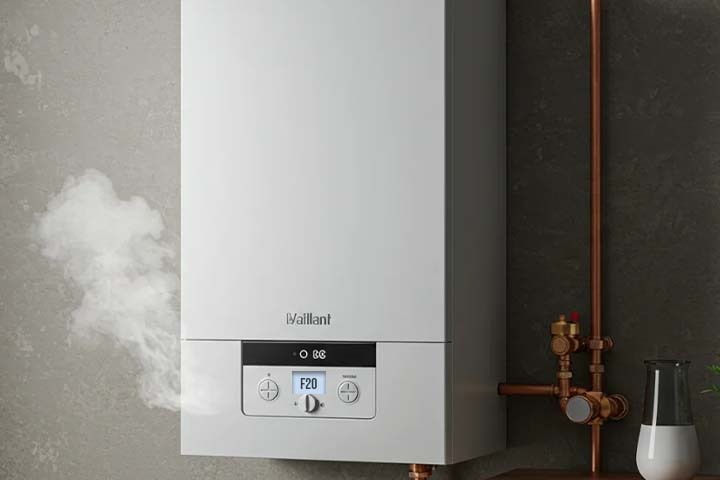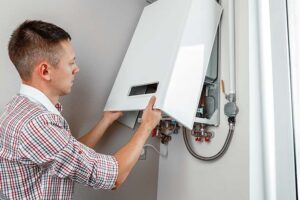Table of Contents
Noticing that your Vaillant boiler is displaying an F20 error? You do not need to worry about it. This is a relatively common boiler fault code and is generally easy to resolve.
The F20 fault code means that your boiler is overheating. This is when the internal temperature has become too hot and has shut it down for safety. It is like a car engine getting too hot and having to cool down before it can continue running.
If your boiler shows this error code, it will not provide heating or hot water until you resolve the issue. In this article, we will inform you why it is happening and how you can quickly repair the F20 error code boiler with a simple reset or by seeking professional help.
What is the Vaillant F20 Error Code?
The F20 code means your boiler is overheating. It is a warning that the temperature has gone higher than it is safe for. To protect itself, your boiler shuts down. It is a lockout. It stops causing harm and saves you.
Vaillant boilers generally come equipped with temperature-watching sensors. When the water in them reaches around 97°C, the boiler turns off.
It usually happens because there is some blockage to the normal flow of water—such as a blockage, low pressure, or faulty element. If it detects unsafe levels of heat, it will shut down until you get it repaired.
Now let’s look for what is behind the F20 error code boiler.
Air Source Heat Pump Grants
What Causes the Vaillant F20 Fault?
There are many things that cause a boiler to overheat. Below are the most common causes:
1. Low or High Pressure & Blockages
If the water pressure is too low or too high, it can stop water from circulating properly. This can make your boiler work too hard and get too hot. Heat can be trapped by blockage in pipes, heat exchangers, or pumps.
2. Broken Fan
The fan cools the boiler. If it does not work, heat accumulates within and causes the F20 fault. This is more prevalent with older boilers.
3. Faulty Thermistor
The thermistor is used to sense temperature. If it is defective, it can give false signals and cause the boiler to shut down even without it needing to.
4. Airlock Within the System
Bubbles can get stuck in the system and block water flowing. This can cause areas of the system to become too hot. A heating engineer can bleed radiators to release air.
5. Heat Exchanger Kettling
If you hear banging or whistling noises, there can be a build-up of limescale in the heat exchanger. This causes hotspots and leads to overheating of the boiler.
6. Limescale near the Thermistor
The accumulation of limescale on the thermistor can lead it to read higher temperatures than are found in the boiler. This can cause a lockout even with overall heat that is safe.
7. Ignition Issues
If there is a fault in the ignition system, the boiler may not burn fuel correctly and generate excessive heat. A heating engineer can clean and inspect the ignition system to sort this out.
Now that we know what causes them, let’s go through how to do Vaillant boiler fault codes troubleshooting.
How to Fix the Vaillant F20 Fault Code?
There are some fixes that you can do yourself, and others require a professional. Let’s go step by step.
1. Try the Vaillant Boiler Fault Code F20 Reset Button
The issue can be fixed by a simple reset. Press the reset button on your boiler control panel and check. If your boiler turns on without re-displaying the F20 code, you are done. If it does not turn on, move on to the next steps.
2. Check the Boiler Pressure
Low pressure (below 1 bar): Refill the system using the filling loop until it reaches 1–1.5 bar.
High pressure (above 2.5 bar): Bleeding radiators to clear air that has become entrapped. Do this using a radiator key.
3. Check the Pump
The pump can be obstructed if it is too noisy or too hot. It can be flushed by a heating engineer or replaced to restore circulation.
4. Check the Thermistor
The temperature sensor on your boiler can be faulty and is giving you false temperature readings. So this may may be due to a boiler temperature sensor fault. If it is limescale-covered, it should be replaced or cleaned.
5. Inspect the Fan
The fan cools the boiler. If it is defective, heat is retained and leads to an F20 fault. It can be repaired or replaced by a competent individual.
6. Flush the Heat Exchanger
Deposits of limescale in the heat exchanger can create hot spots and make it overheat. It can be flushed by a technician or replaced as required.
7. Analyze the Pressure Relief Valve (PRV)
It can create a pressure build-up and cause the boiler to become too hot. It can be cleaned or replaced by a heating engineer.
8. Test the Circulation Pump
If water is not flowing properly, the boiler can become too hot. A heating engineer can inspect the pump for dirt, wear and tear, or damage and replace it if necessary.
9. Clean the System
Power flush clears out dirt and debris and removes limescale from pipes, allowing water to flow freely.
10. Address Kettling Sounds
If your boiler is hissing or clanking, turn it off immediately. This is a symptom that there is a blockage of limescale in the exchanger. Get a Gas-safe engineer before it is too late.
11. Call a Gas Safe Registered Engineer
If you have no idea and the issue persists, it is best to get a professional to check your boiler. Fixing the problem early can save you from costly repairs later.
Why Does My Vaillant Boiler Sound Like a Kettle?
If your boiler is making a whistling or bubbling sound, it is likely kettling. This is caused by water in your boiler that is too hot and starts to boil.
The most common cause is limescale on the heat exchanger. This causes hotspots that can lead to overheating. The boiler can then shut down and show the F20 fault code.
Kettling can damage your heat exchanger and is expensive to replace. If you hear these sounds, turn off your boiler and contact a gas-safe engineer. Early action can save your boiler.
How Can I Fix the F20 Fault if It’s the Fan?
If it is your fan causing trouble, do not make a wild assumption. Have it properly inspected by a Gas-safe engineer. Fans are expensive to replace and it is not worth risking it. In some other cases, you may only need to replace part of your fan — not all of it. That can save you a lot.
Vaillant Boiler Shows F20 and Shuts Off Quickly?
If your boiler shows F20 and shuts down after a short time, it may be a fan problem.
The fan cools down the boiler. If it is not working properly, the boiler will get too hot and shut off. This is more characteristic of older boilers.
The broken fan means it is not able to maintain safe boiler temperatures. It locks out and shows F20. You will need to get it inspected or replaced by an engineer.
Does the F20 Vaillant Boiler Fault Code Mean I Need a New Boiler?
Not necessarily. F20 fault code doesn’t necessarily mean that your boiler has to be replaced. Even so, if your boiler is older than 10 years old, it might be time to consider replacing it. Older models are less efficient and need to be repaired constantly which can get costly.
Vaillant Boiler Fault Code F20: How to Fix It
In most cases, if your boiler is just overheating, letting it cool down and restarting it resolves it. If it still returns, though, it can be a sign of a serious underlying fault.
It is not a DIY job. F20 fault is created by a fault with the thermostat, pump, pressure relief valve, pipes, or heat exchanger—none of which can be repaired by anyone other than a gas-safe engineer. A qualified person can diagnose the root cause and prevent future breakdowns.
Can I Fix the F20 Boiler Fault Myself?
It is not advisable to do it yourself. Don’t do it unless you’re a gas-safe engineer. Boilers are gas and heat-related and it is too big a risk. You may make it worse. You might even invalidate your guarantee or ruin your boiler.
If you’re seeing unfamiliar codes, like an L2 fault, this guide on what L2 means on a boiler can help you understand the issue before calling an expert.
The best thing to do is to call a Gas Safe registered engineer. They are skilled and qualified to diagnose the true cause and fix it properly.
It is advisable to have your boiler serviced every year to avoid future problems. It makes it run safely and smoothly. Most F20 faults are caused by poor repairs or bad installation. So having it inspected by the right person is important.
How to Prevent My Vaillant Boiler from the F20 Error?
The best way to avoid F20 faults is by having regular servicing by a gas-safe engineer. They can spot minor issues before they turn into expensive repairs.
Other ways to protect your boiler:
- Install a magnetic boiler filter to trap debris.
- Add inhibitor fluid to avoid deposits of limescale.
- Install a limescale remover (scale reducer) to prevent buildup.
- If you are in a hard water area, it can cause overheating by forming limescale. Check on the Bristan Hard Water Map to see if you need a limescale reducer.
- Clattering fans or kettling heat exchangers are warning signs—do not ignore them.
Preventative maintenance extends your boiler’s lifespan while also saving you money in the long run.
How Can I Reset My Vaillant Boiler After an F20 Error?
Check for your boiler reset button on the front of your boiler. On most Vaillant models, it looks like a flame with a cross through it. Press and hold this button to reset your boiler.
Note: Only reset the boiler after the F20 issue has been fixed. If the problem is still there, the boiler will lock out again.
Also, let it cool down before you try to reset it. F20 is usually an indication that it was too hot.
In Summary
The Vaillant F20 error usually means your boiler is overheating. It can be caused by a number of factors including a faulty fan, limescale build-up, or bad installation. While some of them may clear on their own after a reset, it is best to let a Gas-safe engineer handle it.
For other common issues like the F1 fault, this quick guide to fixing the Ideal boiler F1 error can help you understand what’s happening and when to call for help.
Don’t try to fix it yourself—it is not safe and can cause more damage. Regular servicing and having a filter fitted to strip out limescale can prevent the F20 fault from reoccurring. Treat your boiler and your boiler will look after your home.
Frequently Asked Questions
The F20 fault means your boiler is overheating. It is typically caused by a faulty fan, low water flow, or heat exchanger fault.
Let the boiler cool down. Then, press and hold the reset button for a few seconds. If it still doesn’t work, get in touch with an engineer.
Find your boiler’s reset button on the front panel (most usually a cross with a flame). Hold for 3–5 seconds and press to reboot.
Your boiler pressure should be between 1 and 1.5 bar on a cold system. If it is too low or too high, it can cause faults.



